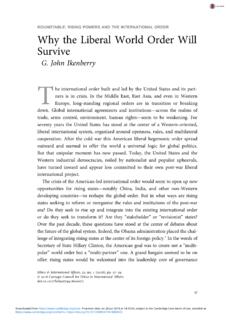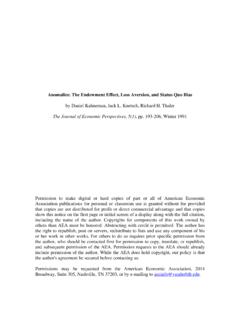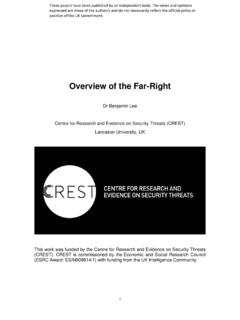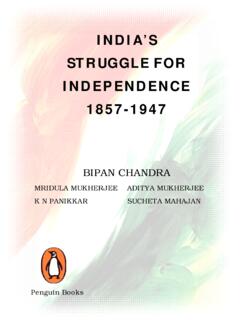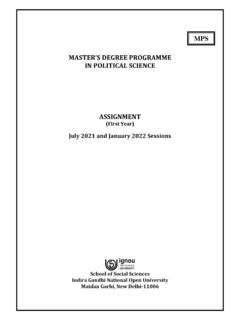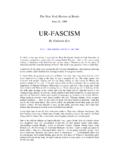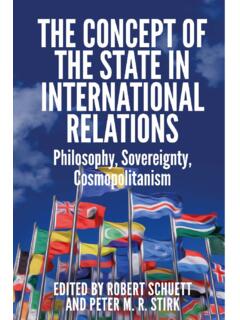Transcription of The end of liberal international order?
1 The end of liberal international order ?G. JOHN IKENBERRYI nternational Affairs 94: 1 (2018) 7 23; doi: The Author(s) 2018. Published by Oxford University Press on behalf of The Royal Institute of international Affairs. All rights reserved. For permissions, please e-mail: seven decades the world has been dominated by a western liberal order . After the Second World War, the United States and its partners built a multifaceted and sprawling international order , organized around economic openness, multilateral institutions, security cooperation and democratic solidarity. Along the way, the United States became the first citizen of this order , providing hegemonic leader-ship anchoring the alliances, stabilizing the world economy, fostering coopera-tion and championing free world values.
2 Western Europe and Japan emerged as key partners, tying their security and economic fortunes to this extended liberal order . After the end of the Cold War, this order spread outwards. Countries in east Asia, eastern Europe and Latin America made democratic transitions and became integrated into the world economy. As the postwar order expanded, so too did its governance institutions. NATO expanded, the WTO was launched and the G20 took centre stage. Looking at the world at the end of the twentieth century, one could be excused for thinking that history was moving in a progressive and liberal internationalist , this liberal international order is in crisis. For the first time since the 1930s, the United States has elected a president who is actively hostile to liberal internationalism.
3 Trade, alliances, international law, multilateralism, environ-ment, torture and human rights on all these issues, President Trump has made statements that, if acted upon, would effectively bring to an end America s role as leader of the liberal world order . Simultaneously, Britain s decision to leave the EU, and a myriad other troubles besetting Europe, appear to mark an end to the long postwar project of building a greater union. The uncertainties of Europe, as the quiet bulwark of the wider liberal international order , have global significance. Meanwhile, liberal democracy itself appears to be in retreat, as varieties of new authoritarianism rise to new salience in countries such as Hungary, Poland, the Philippines and Turkey.
4 Across the liberal democratic world, populist, nationalist and xenophobic strands of backlash politics have deep is this crisis? It might simply be a temporary setback. With new political leadership and renewed economic growth, the liberal order could bounce 1 On the troubles of western liberal democracy, see Edward Luce, The retreat of western liberalism (New York: Atlantic Monthly Press, 2017); Bill Emmott, The fate of the West: the battle to save the world s most successful political idea (New York: Public Affairs, 2017).G. John Ikenberry8 international A1airs 94: 1, 2018back. But most observers think there is something more fundamental going on. Some observers see a crisis of American hegemonic leadership.
5 For 70 years, the liberal international order has been tied to American power its economy, currency, alliance system, leadership. Perhaps what we are witnessing is a crisis of transition , whereby the old US-led political foundation of the liberal order will give way to a new configuration of global power, new coalitions of states, new governance institutions. This transition might be leading to some sort of post-American and post-western order that remains relatively open and Others see a deeper crisis, one of liberal internationalism itself. In this view, there is a long-term shift in the global system away from open trade, multi-lateralism and cooperative security.
6 Global order is giving way to various mixtures of nationalism , protectionism, spheres of influence and regional Great Power projects. In effect, there is no liberal internationalism without American and western hegemony and that age is ending. liberal internationalism is essentially an artefact of the rapidly receding Anglo-American Finally, some go even further than this, arguing that what is happening is that the long era of liberal modernity is ending. Beginning with the Enlightenment and running through the industrial revolution and the rise of the West, world-historical change seemed to be unfolding according to a deep developmental logic. It was a progressive movement driven by reason, science, discovery, innovation, technology, learning, constitutionalism and institutional adaptation.
7 The world as a whole was in the embrace of this global modernizing movement. Perhaps today s crisis marks the ending of the global trajectory of liberal modernity. It was an artefact of a specific time and place and the world is now moving one can be sure how deep the crisis of liberal internationalism runs. In what follows, I argue that, despite its troubles, liberal internationalism still has a future. The American hegemonic organization of liberal order is weakening, but the more general organizing ideas and impulses of liberal internationalism run deep in world politics. What liberal internationalism offers is a vision of open and loosely rules-based order . It is a tradition of order -building that emerged with the rise and spread of liberal democracy, and its ideas and agendas have been shaped as these countries have confronted and struggled with the grand forces of modernity.
8 Creating an international space for liberal democracy, reconciling the dilemmas of sovereignty and interdependence, seeking protections and preserving rights within and between states these are the underlying aims that have propelled liberal internationalism through the golden eras and global catastrophes of the last two centuries. Despite the upheavals and destruction of world war, economic depression, and the rise and fall of fascism and totalitarianism, the liberal interna-2 See G. John Ikenberry, liberal Leviathan: the origins, crisis, and transformation of the American world order (Princeton: Princeton University Press, 2011); Amitav Acharya, The end of American world order (Cambridge: Polity, 2014).
9 3 See Robert Kagan, The world America made (New York: Vintage, 2013). For recent views, see Ian Buruma, The end of the Anglo-American order , New York Times Magazine, 29 Nov. 2016; Ulrich Speck, The crisis of liberal order , The American Interest, 12 Sept. 2016; Michael J. Boyle, The coming illiberal era , Survival 58: 2, 2016, pp. 35 On the crisis of liberal modernity, see Pankaj Mishra, Age of anger: a history of the present (New York: Farrar, Straus & Giroux, 2017).The end of liberal international order ?9 international A1airs 94: 1, 2018tional project survived. It is likely to survive today s crises as well. But to do so this time, as it has done in the past, liberal internationalism will need to be rethought and make this argument in three steps.
10 First, I offer a way of thinking about liberal internationalism. It is not simply a creature of American hegemony. It is a more general and longstanding set of ideas, principles and political agendas for organizing and reforming international order . In the most general sense, liberal internationalism is a way of thinking about and responding to modernity its opportunities and its dangers. What has united the ideas and agendas of liberal internationalism is a vision of an open, loosely rules-based and progressively oriented international order . Built on Enlightenment foundations, it emerged in the nineteenth century with the rise in the West of liberalism, nationalism , the industrial revolution, and the eras of British and American hegemony.







